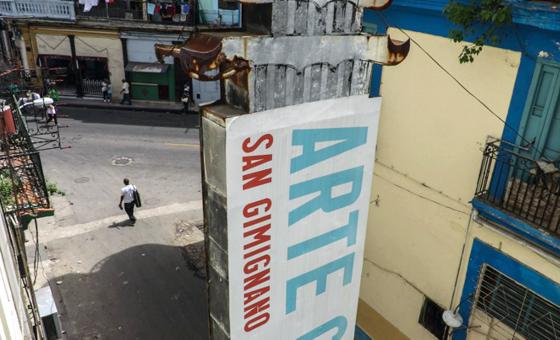The first ever international contemporary art space in Cuba has been opened by Italians.
For decades, Cubans have been used to the revolutionary slogan "La lucha continua," or "the struggle goes on."
Now the first ever international contemporary art space on the Communist-ruled island has been dubbed "Arte Continua," or "art goes on," reflecting the changes shaping Havana.
The concept, originally from Italy, brings leading contemporary artists to an island that has been under one-party rule for more than half a century.
It is an offshoot of a project called "Galleria Continua" which started when Italians Mario Cristiani, Lorenzo Fiaschi and Maurizio Rigillo had the idea of setting up contemporary art spaces in the most unlikely places, starting in 1990 in the medieval Italian village of San Gimignano. They scored a notable coup when they installed a gallery in China in 2005.
The Havana space includes work from big names including Michelangelo Pistoletto, Daniel Buren of France, British-Indian artist Anish Kapoor, India's Shilpa Gupta and the late Greek-Italian artist Jannis Kounellis.
Pistoletto has already put on his own performance art show in Havana, when he smashed mirrors with a giant hammer in front of a stunned audience in the old city's 18th century San Francisco de Paula church.
Non-profit art
Fiaschi says he had the idea of installing an art exhibit space in Cuba during a visit in 2014, when he stumbled upon the ruined shell of a 1950s cinema in the old Chinese quarter of Havana.
Working with the Cuban authorities, he transformed the space and baptized it "Arte continua" to signify that unlike its predecessors, this was not an actual gallery but more in line with Cuba's cultural centers.
As well as sculptures, the space will feature musical events, dance, theatre and photographic and architectural exhibits.
"We are the first non-Cuban exhibition space in Cuba," said Luisa Ausenda, one of the organizers of "Arte Continua," boasting of the project's pioneering, non-profit role.
Under a deal with the Communist authorities, the pieces on display will not be for sale. Nevertheless, the concept has succeeded in luring some of the biggest names in the contemporary art world to Cuba, thanks in part to private sponsorship and the collaboration of diplomatic missions in Havana.
Import and export of artists
"We have a dual mission," said Ausenda. "On the one hand, we want to bring renowned international artists here, while on the other hand, we want to help the development of Cuban artists, both here on the island and abroad."
With support from "Arte continua," local artists Reynier Leyva Novo and Jose Eduardo Yaque were able to take their work to the Venice biennale and other "Galleria continua" spaces.
The Havana space also organizes a regular cinema club, guided tours and community workshops that cater to local schoolchildren.
"It's a positive project," said Jorge Fernandez, director of Cuba's Museum of Fine Arts and the Havana biennale.
"They bring in artists but above all, they work with the local community, with children. They are not here to sell pictures, and that is what we must promote."
Agence France Presse
























































